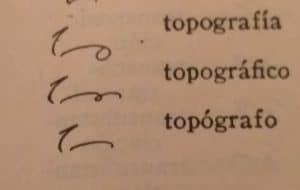The suffixes -ograph and -egraph are represented by an O-hook and an over-E, respectively, in English Gregg Shorthand.
In Portuguese, telegrafia with an over-A loop and taquígrafo with an over-E.

In Italian, telegrafo with an E (like the “ing” dot), fotografo with an O-hook and stenografia with a OA.

In French, photographe with an O-hook and télégraphe with an over-E.

But in Spanish, telégrafo, taquígrafo, topografía, topógrafo and so on with a G sign. Why?


In the 1921 edition of Taquigrafía Gregg, the English abbreviations were used (e circle for -é/ígrafo, the loop for -e/igrafía), but that was changed in the 1923 edition. I don't know the reason. I think this also reflects on having 5 different authors for each of the adaptations, right? Can't they all agree on how to do it?
Those official Spanish suffixes are silly, in my opinion: use the English convention, and reserve the disjoined g for -grama.
Hi Carlos
Could it be possible to know that 1921 edition… pleeeeease? 😀
I'll use the English convention for those suffixes.
Thanks for your answer.
Hugs
Wow! This looks like a mess. But some of the problem may lie in Gregg's adoption of -egraph and -ograph as word endings.Despite his usually very savvy approach to things, I think these were bad choices. Indeed, they were done away with in Simplified, but that led to awkward full spelling of -graph.
Now, Series 90 (for English) uses an attached g for -graph. I find that greatly preferable to -egraph and -ograph stuff. For one thing, it's more like the detached g for -gram. Consider these words, and how you might write them in various series of Gregg Shorthand:
(1) telegram, photogram, pentagram, trigram, diagram;
(2) telegraph, photograph, pentagraph, trigraph, diagraph.
There's much greater uniformity here in S90. It's one of the very few things that I think are superior in S90 to what came before.
Hi LVW <– ?
Very interesting what you have explained; in fact, I prefer joined suffixes such of those you mentioned.
I think I'll do it that way.
Thanks
The Gregg way of dealing with -egraph and -ograph seperately is a strange choice. Even back in the day, there only is "telegraph" and that is a single word family.
If disjoined "a" can represent -atic, -etic, -itic, -otic and -utic, why didn't Gregg choose disjoined "o" to represent -ograph and -egraph. In fact why not -(vowel)graph? This design decision has always baffled me.
That being said, don't get me started on my disatisfaction of the -tic endings.
Hi Niten Ichi:
Agreed!!!
The same for -tic endings hahaha